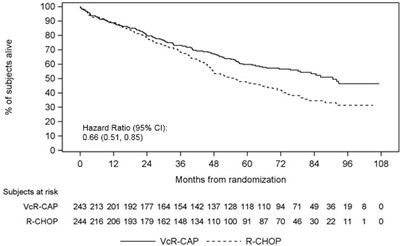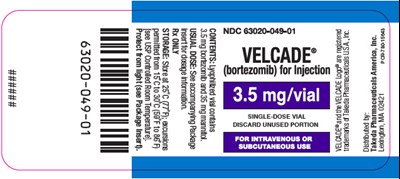Product Images Velcade
View Photos of Packaging, Labels & Appearance
Product Label Images
The following 9 images provide visual information about the product associated with Velcade NDC 63020-049 by Takeda Pharmaceuticals America, Inc., such as packaging, labeling, and the appearance of the drug itself. This resource could be helpful for medical professionals, pharmacists, and patients seeking to verify medication information and ensure they have the correct product.
Figure 2 - velcade 05

This is a table that shows the number of patients remaining after a certain time point and the corresponding p-values from a log-rank test. The treatment options being compared are Bortezomib and Dexamethasone. The numbers in the table seem to represent the number of patients who survived after the given time, grouped by a certain range.*
Figure 4 - velcade 07

This appears to be a graph showing survival rates for two different treatment groups over time. The names of the treatment groups are not available, but they are labeled as "VGR-CAP" and "R-CHOP". The graph shows the percentage of subjects still alive at different time points from the start of the study, and includes a Hazard Ratio value with a confidence interval. It seems like the graph is showing that the survival rate for the VGR-CAP group is higher than the survival rate for the R-CHOP group.*
Figure 5 - velcade 08

VELCADE® is a prescription medicine used to treat multiple myeloma and mantle cell lymphoma. It contains 3.5 mg of bortezomib and 35 mg of mannitol per vial. It should be stored at 25°C (77°F) and protected from light. Dosage information is available in the accompanying package insert.*
* The product label images have been analyzed using a combination of traditional computing and machine learning techniques. It should be noted that the descriptions provided may not be entirely accurate as they are experimental in nature. Use the information in this page at your own discretion and risk.





